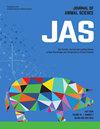Effects of chicken slurry inclusion on apparent total tract macronutrient digestibility, palatability, and fecal characteristics, microbiota, and metabolites of healthy adult dogs
IF 2.7
2区 农林科学
Q1 AGRICULTURE, DAIRY & ANIMAL SCIENCE
引用次数: 0
Abstract
“Premium” pet foods are often formulated with meat slurries. Meat slurries are believed to be of higher quality than rendered meals, but inadequate research has been performed to test how their inclusion affects palatability, digestibility, or indicators of gastrointestinal health. Therefore, the objectives of this study were to determine how chicken slurry inclusion affected the palatability and apparent total tract macronutrient digestibility (ATTD) of dog foods and to assess their effects on the fecal characteristics, metabolites, and microbiota of dogs. A replicated 3x3 Latin square design digestibility study was conducted using 9 healthy adult dogs (age = 5.44 ± 0.53 yr) to test diets containing 0% (control; CON), 8% (low inclusion; LOW), and 16% (high inclusion; HIGH) chicken slurry. The experiment comprised three 21-day experimental periods (14 days of adaptation, 5 days of total fecal collection (used for ATTD calculations), and 2 days of blood collection). On the first day of fecal collections, one fresh sample was collected for measurement of pH, dry matter (DM) content, fermentative metabolite concentrations, and microbiota populations. A 2-day palatability study (n=20 dogs) was also conducted to compare CON vs. HIGH. Data were analyzed statistically by Mixed Models using SAS 9.4, with P<0.05 being significant. In the palatability study, dogs were shown to prefer (P<0.05) the HIGH diet by a ratio of 2:1. In the digestibility study, fecal output, scores, pH, and DM percentage were not different among diets. The ATTD of protein was higher (P<0.05) for the HIGH diet (84.6%) than for the LOW (82.7%) or CON (82.6%) diets. The ATTD of other nutrients and energy were not different among diets (all over 80%). Fecal propionate, butyrate, and total short-chain fatty acid concentrations were higher (P<0.05) in dogs fed the LOW diet (122.0, 67.4, and 408.2 βmol/g, respectively) than those fed the HIGH diet (89.0, 46.9, and 338.2 βmol/g, respectively). The other fecal metabolites (acetate, branched-chain fatty acids, ammonia, phenol, and indole) were not different among treatments. Few changes to the fecal microbiota were noted. However, the relative abundance of fecal Fusobacterium was higher (P<0.05) in dogs fed the CON diet than those fed the HIGH diet (25.% vs. 20.0% relative abundance). In summary, chicken slurry inclusion improved palatability but had minimal effects on nutrient digestibility and fecal characteristics, metabolites, and microbiota.加入鸡肉泥对健康成年狗的表观总道宏量营养素消化率、适口性、粪便特征、微生物群和代谢物的影响
"高级 "宠物食品通常使用肉泥配制。人们认为肉浆的质量要高于肉粉,但目前还没有足够的研究来测试加入肉浆对适口性、消化率或胃肠道健康指标的影响。因此,本研究的目的是确定鸡肉泥如何影响狗粮的适口性和表观总道常量营养素消化率(ATTD),并评估其对狗粪便特征、代谢物和微生物群的影响。我们使用 9 只健康的成年狗(年龄 = 5.44 ± 0.53 岁)进行了一项重复的 3x3 拉丁正方形设计消化率研究,测试了含 0%(对照组;CON)、8%(低含量;LOW)和 16%(高含量;HIGH)鸡肉泥的狗粮。实验包括三个 21 天的实验期(14 天的适应期、5 天的粪便收集期(用于计算 ATTD)和 2 天的采血期)。在收集粪便的第一天,收集一份新鲜样本,用于测量 pH 值、干物质(DM)含量、发酵代谢物浓度和微生物群数量。还进行了为期 2 天的适口性研究(20 只狗),以比较 CON 与 HIGH。数据采用 SAS 9.4 混合模型进行统计分析,P<0.05 为显著。在适口性研究中,狗更喜欢(P<0.05)HIGH 日粮,比例为 2:1。在消化率研究中,不同日粮的粪便排出量、评分、pH 值和 DM 百分比均无差异。HIGH日粮的蛋白质ATTD(84.6%)高于LOW日粮(82.7%)或CON日粮(82.6%)(P<0.05)。其他营养物质和能量的 ATTD 在不同日粮中没有差异(均超过 80%)。饲喂 LOW 日粮的狗的粪便丙酸盐、丁酸盐和总短链脂肪酸浓度(分别为 122.0、67.4 和 408.2 βmol/g)高于饲喂 HIGH 日粮的狗(分别为 89.0、46.9 和 338.2 βmol/g)(P<0.05)。其他粪便代谢物(醋酸、支链脂肪酸、氨、酚和吲哚)在不同处理之间没有差异。粪便微生物群几乎没有变化。不过,饲喂 CON 日粮的狗粪便中镰刀菌的相对丰度(P<0.05)高于饲喂 HIGH 日粮的狗(相对丰度分别为 25.% 和 20.0%)。总之,添加鸡肉泥可改善适口性,但对营养消化率、粪便特征、代谢物和微生物群的影响很小。
本文章由计算机程序翻译,如有差异,请以英文原文为准。
求助全文
约1分钟内获得全文
求助全文
来源期刊

Journal of animal science
农林科学-奶制品与动物科学
CiteScore
4.80
自引率
12.10%
发文量
1589
审稿时长
3 months
期刊介绍:
The Journal of Animal Science (JAS) is the premier journal for animal science and serves as the leading source of new knowledge and perspective in this area. JAS publishes more than 500 fully reviewed research articles, invited reviews, technical notes, and letters to the editor each year.
Articles published in JAS encompass a broad range of research topics in animal production and fundamental aspects of genetics, nutrition, physiology, and preparation and utilization of animal products. Articles typically report research with beef cattle, companion animals, goats, horses, pigs, and sheep; however, studies involving other farm animals, aquatic and wildlife species, and laboratory animal species that address fundamental questions related to livestock and companion animal biology will be considered for publication.
 求助内容:
求助内容: 应助结果提醒方式:
应助结果提醒方式:


